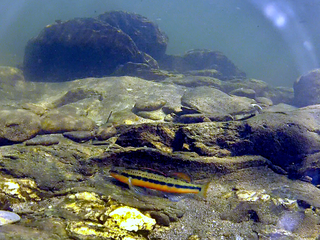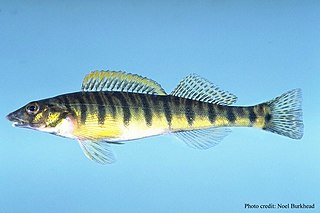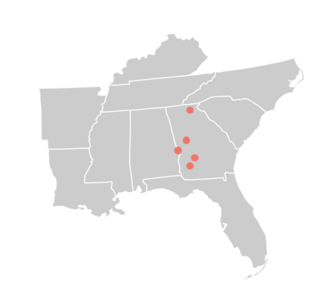
The leopard darter is a species of freshwater ray-finned fish, a darter from the subfamily Etheostomatinae, part of the family Percidae, which also contains the perches, ruffes and pikeperches. It is native to the United States, where it can be found only in the Little River drainage in Oklahoma and Arkansas. Its typical habitat is medium to large streams with rubble and boulder substrate. It feeds on small invertebrates on the riverbed and spawns mainly in March and April. It is threatened by impoundment, habitat loss and runoff from agricultural activities. It has never been a common species and has been listed as a threatened species in the United States since 1978, and the International Union for Conservation of Nature lists it as a "vulnerable species".

The rainbow darter is a small species of freshwater ray-finned fish, a darter from the subfamily Etheostomatinae, part of the family Percidae, which also contains the perches, ruffes and pikeperches. It is native to North America where it is found in small, fast-moving streams and small to medium-sized rivers. It grows to 2 to 3 inches in length. The species is very sensitive to pollution and silt, staying in clean, pollution-free water. The rainbow darter is easily identified by three dark spots on the back, and blue and orange in the dorsal and anal fins.

The tangerine darter or river slick is a small species of freshwater ray-finned fish, a darter from the subfamily Etheostomatinae, part of the family Percidae, which also contains the perches, ruffes and pikeperches. It is found in the eastern United States. It grows to a length of 4.3 to 7.1 inches, males being bright orange-red while females are yellow. It is insectivorous, picking insect larvae off aquatic plants and the riverbed, and sometimes rolling small stones over to expose prey. It breeds in late spring and early summer, typically in shallow sandy or gravelly riffles. Pollution and habitat degradation may be a problem in parts of its range, however it is a fairly common fish with a wide range and the International Union for Conservation of Nature has classified its conservation status as being of "least concern".

The Roanoke logperch is a species of freshwater ray-finned fish, a darter from the subfamily Etheostomatinae, part of the family Percidae, which also contains the perches, ruffes and pikeperches. It is found in the Roanoke and Chowan drainages in Virginia and North Carolina in the United States. They inhabit low and moderate-gradient streams and rivers in warm, clear water in mostly unsilted gravel and rubble in runs, pools, and riffles. They are primarily insectivorous. This fish is a federally listed endangered species.

The Conasauga logperch is a species of freshwater ray-finned fish, a darter from the subfamily Etheostomatinae, part of the family Percidae, which also contains the perches, ruffes and pikeperches. It is endemic to the United States. It is one of 184 species of darters in North America. It has been listed as endangered throughout its range with critical habitat under the U.S. Endangered Species Act since August 5, 1985.

The channel darter is a species of freshwater ray-finned fish, a darter from the subfamily Etheostomatinae, part of the family Percidae, which also contains the perches, ruffes and pikeperches. It is native to North America where it typically occurs in the sandy or gravelly shallows of lakes and in small and medium-sized rivers in riffles over sand, gravel or rock bottoms. It is a small fish ranging from 34 to 72 mm in length, olive brown with darker speckles and sometimes with a dark spot below the eye and dark blotches along the flank. It feeds mostly on insect larvae and other small invertebrates and breeds in small streams. This species is listed as threatened by the Canadian Species at Risk Act (SARA) but overall it has a wide range and numerous sub-populations and the International Union for Conservation of Nature has rated it as a "least concern species".
The emerald darter, is a species of freshwater ray-finned fish, a darter from the subfamily Etheostomatinae, part of the family Percidae, which also contains the perches, ruffes and pikeperches. It is found only in northern and eastern Kentucky and northeastern Tennessee.
The corrugated darter is a species of freshwater ray-finned fish, a darter from the subfamily Etheostomatinae, part of the family Percidae, which also contains the perches, ruffes and pikeperches. It is endemic to the eastern United States only known from Caney Fork, Tennessee, where it has been shown to have as many as five subgroups. They are active hunters which prey on insects, fry, and possibly young snails. Multiple species and subspecies of these darters can coexist where substrate is varied, so this must be carefully preserved to accommodate many similar species. With the warming of spring, E. basilare enters its breeding cycle and males develop their dimorphic coloration. Like most darters, it hugs the stream bed, using its body shape and fin posture to maintain its position.

The gulf darter is a species of freshwater ray-finned fish, a darter from the subfamily Etheostomatinae, part of the family Percidae, which also contains the perches, ruffes and pikeperches. It is found in Louisiana, Mississippi, Alabama, Florida, Tennessee, and Kentucky. It is a colorful fish, males having vertical barring of red-orange and blue-green near the tail, growing to a length of about 7.8 centimeters (3.1 in). It is typically found in small and medium-sized creeks, often in very shallow water. It occurs over sandy bottoms and among aquatic vegetation such as Sparganium americanum, foraging among the plants and organic debris for insect larvae and small invertebrates. The International Union for Conservation of Nature has assessed its conservation status as being of "least concern".

The gilt darter is a species of freshwater ray-finned fish, a darter from the subfamily Etheostomatinae, part of the family Percidae, which also contains the perches, ruffes and pikeperches. It can be found in a number of states in the Mississippi River drainage of the United States although it has been extirpated from some river systems in which it was at one time present, mostly due to siltation and pollution problems. Males are more colorful than females and can grow to a length of about 9 cm (3.5 in). It is a benthic fish that feeds primarily on small aquatic insect larvae. Males form territories during the breeding season in late spring and early summer. Spawning typically takes place at the upper ends of riffles with sandy and gravelly bottoms interspersed with larger cobbles. Some organisations are endeavouring to conserve populations of the gilt darter and re-introduce it to states where the fish has been extirpated but suitable habitat still exists.
Percina kusha, the bridled darter, is a species of freshwater ray-finned fish, a darter from the subfamily Etheostomatinae, part of the family Percidae, which also contains the perches, ruffes and pikeperches. It is one of the 324 fish species found in Tennessee.

The Mobile logperch is a species of freshwater ray-finned fish, a darter from the subfamily Etheostomatinae, part of the family Percidae, which also contains the perches, ruffes and pikeperches. It is found in the Mobile River basin in Mississippi, Alabama, Tennessee, and Georgia in the southeastern United States. It inhabits clear shallow water and is often associated with Podostemum (riverweed). It grows to about 18 cm (7 in) and is distinguishable from other darters by the distinctive shape of its head and by its pale-yellow base color, with narrow bars on back and sides. It feeds on small invertebrates and breeds between February and May. Lake fish move into small streams to spawn. It is a common fish with a wide range and the International Union for Conservation of Nature has classified its conservation status as being of "least concern".

Percina maculata, the blackside darter, is a species of freshwater ray-finned fish, a darter from the subfamily Etheostomatinae, part of the family Percidae, which also contains the perches, ruffes and pikeperches. It is a widespread inhabitant of streams and rivers in the Mississippi River watershed. Like other darters it prefers rocky riffles and sandy runs, but is tolerant of pools and still water as well. It is one of the 324 fish species found in Tennessee.

The blackbanded darter is a species of freshwater ray-finned fish, a darter from the subfamily Etheostomatinae, part of the family Percidae, which also contains the perches, ruffes and pikeperches. It is native to the river systems of the southeastern United States where it is found in the states of South Carolina, Tennessee, Georgia, Florida, Mississippi, Alabama, and Louisiana. It lives over sandy or gravelly bottoms in smaller rivers and streams and its color varies depending on the different habitats in which it lives. It feeds on small insect larvae and is itself preyed on by larger fish. It spawns between February and June depending on locality. It is a common fish throughout most of its range but is rare in the Altamaha River in Georgia.
Percina shumardi is a benthic species of freshwater ray-finned fish, a darter from the subfamily Etheostomatinae, part of the family Percidae, which also contains the perches, ruffes and pikeperches. It is native to North America. It is an inhabitant of small and medium rivers where it occurs in rocky riffles with clear, fast-flowing water. The river darter can reach up to 7.3 cm in length and has an average lifespan of three years. It can be distinguished from other darters by its unique front and rear spots on the dorsal fin.
The frecklebelly darter is a species of freshwater ray-finned fish, a darter from the subfamily Etheostomatinae, part of the family Percidae, which also contains the perches, ruffes and pikeperches. It primarily occurs in the upper Kentucky and Green river systems of eastern and central Kentucky and north-central Tennessee, being found mostly in the Cumberland Plateau and Highland Rim regions. The fish gets its name from gets its name from the scattered dark spots on its relatively pale underside. However, a possible more telling characteristic of the species is the systematical arrangement of the spots at the base of the tail as well as the continuous stripes down either side of the back. Total population size is unknown but figured to be relatively large. The frecklebelly darter is a benthic darter that relies on invertebrates as its principal diet. The frecklebelly darter can be found primarily in creeks and small rivers with a moderate gradient and a pool/riffle type flow, and spends most of its time in midwater areas of the stream. The major threats of the frecklebelly darter include decimation through perturbations such as strip mining as well as stream channelization projects. The darter is thought to have a high resilience with minimum population doubling time less than 15 months; it is also believed to have low vulnerability. Frecklebelly darter females contain about 100-300 mature ova depending on size. Fish become mature by age 1. Spawning in this darter species involves egg burial where the male mounts the female and deposits eggs in deep depressions created by receptive females.
The saddleback darter is a species of freshwater ray-finned fish, a darter from the subfamily Etheostomatinae, part of the family Percidae, which also contains the perches, ruffes and pikeperches. It is native to the eastern United States. This darter species is widespread, occurring from the Escambia River drainage west to the Mississippi River basin and as far north as the Wabash River historically. Some populations have been reported in the Tennessee River drainage. The saddleback darter is aptly named as it has 5 saddle-like patterns on its dorsum, with the first occurring near the first dorsal fin and the fifth near the caudal penduncle. Adults can attain a maximum size of about 3 inches or 7.8 centimeters. The saddleback darter typically occurs over sand and gravel runs of creeks and small to medium-sized rivers and is sometimes found in very shallow water. This darter's diet consists of invertebrates such as caddisfly larvae, beetles, mayflies, and stoneflies. The saddleback darter deposits eggs over sand and gravel shoals during the spring. This species has an average lifespan between 2 and 3 years.
The sickle darter is a recently identified freshwater ray-finned fish, a darter from the subfamily Etheostomatinae, part of the family Percidae, which also contains the perches, ruffes and pikeperches. It is closely related to a well-known darter, Percina macrocephala. Discovered in 2007 in the upper Tennessee River drainage, the sickle darter is a small ,slender bodied, freshwater and benthopelagic fish that most likely feeds on small crayfish and mayflies since it shares a large mouth and long snout with its sister species. The known distribution of the sickle darter is the upper drainage of the Tennessee River of Tennessee, North Carolina and Virginia. It is distinguished from all other Percina darters except its sister species P. macrocephala by a dark suborbital bar and a black bar subtending a medial black spot on the base of the caudal fin. It stays in mostly rocky, sandy, or silty substrates in clear creeks or small rivers in the Appalachian Mountains. The sickle darter spawns in late winter in gravel shoals. It also has large scales which make it different from macrocephala. It's known to be extirpated from most of its home habitat mainly because of agricultural practices that cause siltation and turbidity which causes most populations of the sickle darter to be widely scattered. But where it is found, it can be observed with regularity. Taking all this into consideration, the sickle darter does not have a formal conservation status under any federal or state law although its closely related species is considered a species of concern by the TWRA. Future management plans should include finding more locations of the sickle darter and decreasing further habitat destruction in known distributions by stating it as a fish of concern by state law.

Percina roanoka, the Roanoke darter, is a species of freshwater ray-finned fish, a darter from the subfamily Etheostomatinae, part of the family Percidae, which also contains the perches, ruffes and pikeperches. It isnative to Virginia, West Virginia and North Carolina in the United States. It is found in the Roanoke, Tar, and Neuse river systems, typically in small to medium size rivers. It is a colorful species with an average length of 4.3 centimeters (1.7 in). It feeds on insect larvae and other small invertebrates, and spawns in late May and June. It is a common fish with a very wide range and the International Union for Conservation of Nature has classified its conservation status as being of "least concern".

The Halloween darter is a small freshwater fish native to North America. It is found in Georgia and Alabama in the drainage basin of the Apalachicola River, specifically in the Flint River system and the Chattahoochee River system. It prefers shallow, fast-flowing areas with gravel bottoms in small and medium-sized rivers. It was first described in 2008, having not previously been distinguished from the blackbanded darter (P. nigrofasciata), which occurs in the same watershed. The color is somewhat variable, being generally blackish dorsally, with some individuals having indistinct saddle-like barring. Males have orange and dark lateral striping while females have dark stripes and a yellowish-green belly. At a maximum standard length of 101 mm (4 in), males are slightly larger than females, and both sexes develop distinctive orange barring on the edge of the first dorsal fin during the breeding season.














